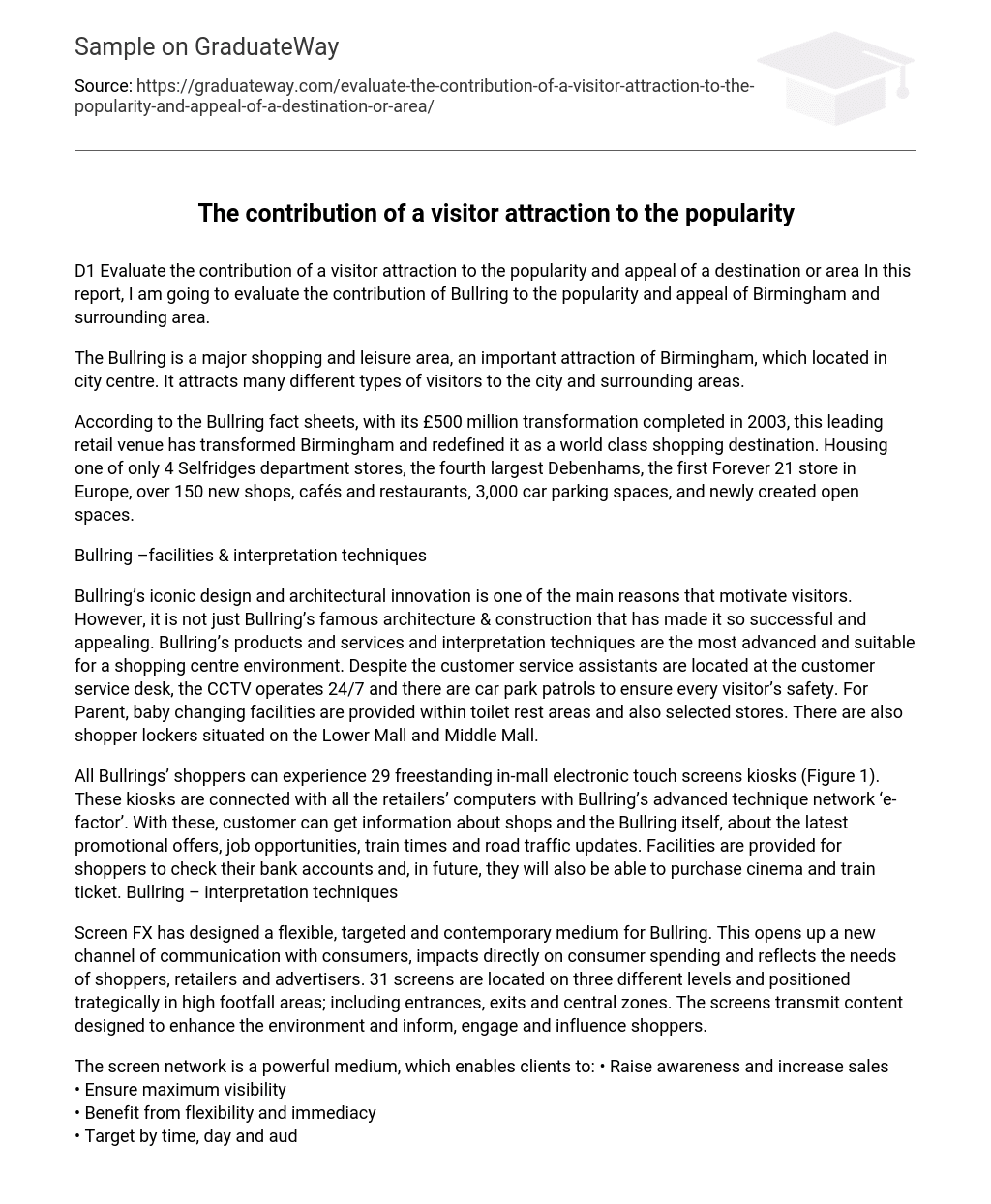D1: Evaluate the contribution of a visitor attraction to the popularity and appeal of a destination or area. In this report, I am going to evaluate the contribution of the Bullring to the popularity and appeal of Birmingham and the surrounding area.
The Bullring is a major shopping and leisure area and an important attraction in Birmingham, located in the city centre. It attracts many different types of visitors to the city and surrounding areas.
According to the Bullring fact sheets, with its £500 million transformation completed in 2003, this leading retail venue has transformed Birmingham and redefined it as a world-class shopping destination. It houses one of only four Selfridges department stores, the fourth largest Debenhams, the first Forever 21 store in Europe, over 150 new shops, cafés, and restaurants, 3,000 car parking spaces, and newly created open spaces.
Bullring: Facilities and Interpretation Techniques
Bullring’s iconic design and architectural innovation are some of the main reasons that motivate visitors. However, it is not just Bullring’s famous architecture and construction that have made it so successful and appealing. Bullring’s products, services, and interpretation techniques are the most advanced and suitable for a shopping center environment. Despite the customer service assistants being located at the customer service desk, the CCTV operates 24/7, and there are car park patrols to ensure every visitor’s safety. For parents, baby changing facilities are provided within toilet rest areas and selected stores. There are also shopper lockers situated on the Lower Mall and Middle Mall.
All Bullring shoppers can experience 29 freestanding in-mall electronic touch screen kiosks (Figure 1). These kiosks are connected to all the retailers’ computers through Bullring’s advanced network technique, ‘e-factor’. Customers can use these kiosks to obtain information about shops and the Bullring, including the latest promotional offers, job opportunities, train times, and road traffic updates. Facilities are also provided for shoppers to check their bank accounts, and in the future, they will be able to purchase cinema and train tickets. Bullring – interpretation techniques.
Screen FX has designed a flexible, targeted, and contemporary medium for Bullring. This opens up a new channel of communication with consumers, impacts directly on consumer spending, and reflects the needs of shoppers, retailers, and advertisers. Thirty-one screens are located on three different levels and positioned strategically in high footfall areas, including entrances, exits, and central zones. The screens transmit content designed to enhance the environment and inform, engage, and influence shoppers.
The screen network is a powerful medium that enables clients to:
- Raise awareness and increase sales
- Ensure maximum visibility
- Benefit from flexibility and immediacy
- Target by time, day, and audience profile
- Create high-impact campaigns using multiple messages
Bullring has gained popularity in the region and worldwide.
Bullring is now Birmingham’s most recognized city emblem, which has led to attracting people not just living in Birmingham but also in regional areas such as Telford, Coventry, and Stafford. Picture 1 is from the Bullring media brochure, which shows the catchment of Birmingham and its surroundings. Based on statistics from the Bullring media brochure, within a 60-minute drive time, there are 7.2 million people, with 4.3 million of these within a 45-minute drive time. The total annual spend within our catchment area on non-food product categories is 7.3 billion per annum.
Consequently, the shopping centre has been a huge success, attracting customers from all over the world, including New York. Based on average annual figures for city visits from 2005 to 2009, the statistics show that Birmingham receives 737,000 overnight-stay visits from overseas tourists per year.
Birmingham’s tourist industry has significantly benefited from the success of Bullring, with hotel operators in the city reporting an increase in weekend trade. In the first 12 months since Bullring opened, hotel occupancy rates for weekend stays in the city overall rose by 8%. Over 8,000 new jobs have been created within Bullring as a result of its development.
Since the launch of Bullring, its popularity has grown worldwide. Birmingham has risen from 13th to 3rd in the Experian UK retail destination rankings. Bullring is now officially one of the most visited shopping centres in the UK, with over 38.5 million visitors recorded last year alone. It continues to attract high-quality national and international brands, with recent additions including style-leaders such as A|X Armani Exchange, DKNY Jeans, Kurt Geiger, Tommy Hilfiger, and Ben Sherman.
This has led to more restaurants and hotels being established, such as Radisson Blu, which was established in Birmingham in 2006. Besides, Bullring has generated even more popularity and awareness for some of the top brands. Out of all the potential launch venues in the UK for Range Rover, this famous car brand chose Bullring as the platform for its customer launch of the new Range Rover Sport. Bullring was also selected as part of an international marketing campaign to endorse Johnnie Walker as the new F1 team McLaren sponsor.
Bullring – Further Development and Big City Plan
Regeneration around the Bull Ring continues. In December 2011, the expansion of Bullring was completed with the creation of three new restaurant units around St. Martin’s Church. The three new restaurants have all been leased, with Browns Bar and Brasserie and Chaobaby opening their first restaurants in Birmingham. In addition to the existing restaurants, this has created a hub of seven restaurants named Special Street (Picture 3).
In addition, the Bullring is a large part of the Big City Plan. The scheme is a major development plan for Birmingham that was launched on September 29, 2010.
The success of tourism in Birmingham has boosted the expansion and development of Birmingham and its surrounding areas. The main purpose of the plan is to expand the size of the city core and develop the surrounding areas. The plan is still undergoing, and Birmingham expects to see improvements over the next 20 years. The city centre population will grow, providing more than 5,000 homes and 50,000 new jobs.
Reference:





